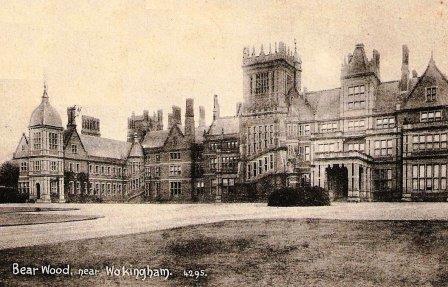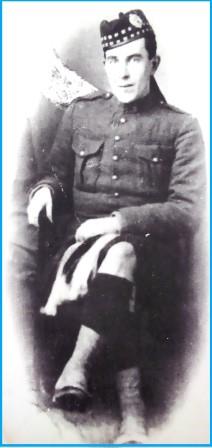March 21, 2024. In Part 1 of the WWI letters of Lawrence Ivy MARSHALL, of Covehead, Prince Edward Island, which had been shared by his granddaughter, Connie Birt Paynter, Lawrence was among the first Canadians to volunteer for WWI in 1914. After his initial training in Valcartier, Quebec, he informed his family that he was about to go overseas. (See https://onthewarmemorialtrail.com/2024/03/02/on-the-war-memorial-trail-the-wwi-letters-of-lawrence-ivy-marshall-part-1-valcartier-camp/)
In Part 2, Lawrence described his experiences aboard one of the first troop ships to England. (See https://onthewarmemorialtrail.com/2024/03/08/on-the-war-memorial-trail-the-wwi-letters-of-lawrence-ivy-marshall-part-2-the-voyage-to-england/)
In Part 3, Lawrence was on the front lines in trenches in Belgium and France, when he dislocated his elbow and was sent back to England for treatment. (See https://onthewarmemorialtrail.com/2024/03/15/on-the-war-memorial-trail-the-wwi-letters-of-lawrence-ivy-marshall-part-3-in-the-trenches/)
Now, in Part 4, Lawrence spent weeks in England recuperating before returning to active service at the front.
….Lawrence was operated on to straighten his elbow….

Postcard of the operating theatre at North Evington War Hospital. Masks were not mandatory.
Lawrence remained at North Evington War Hospital in Leicester for 7 weeks. On September 26, 1915, he gave an update to his father. “…I am still in the hospital … and will be for a while, I think. My arm is not any straighter yet. I have to go to the operating room this morning. They are going to try and straighten it. I have been under ether three times now. I am getting tired of it too. If they can’t straighten it this time I will not go back to the front any more. It doesn’t bother me. I can use it as good as ever before and I can bend it….”

The Canadian Convalescent Hospital in Bear Wood. (Photo source: http://www.arborfieldhistory.org.uk)
On October 23, 1915, Lawrence was transferred to the Canadian Convalescent Hospital in Monks Horton, then 3 days later to the Canadian Convalescent Hospital in Bear Wood, Wokingham, Berkshire, England. The hospital, which housed 900 Canadian soldiers, had been a private home with 90 bedrooms, belonging to Mrs. Walter, the widow of the Times newspaper owner.
From Bear Wood, Lawrence wrote his mother on October 30, 1915. “…I am in a convalescent hospital in Berkshire. It is a very good place but awful lonesome. We are away in the country here on a large estate…..About my arm. It is doing fine now. It is almost as straight as ever but I cannot do any work with it yet. There is no strength in it...”
….Lawrence returned to duty….
On November 15, 1915, Lawrence was released from hospital and given a short furlough before being assigned to the 48th Highlanders Canada, 43rd Reserve Battalion.
On November 27, 1915, in a letter to his father, written from East Sandling Kent, he noted that he was “…back with my battalion again… I guess I have to go back to France after Xmas, if not before, but I hope not. There are a lot of our boys going back there Monday. I very near got sent too only my arm is not quite right yet. It still gets sore and stiff… in cold weather...”
On January 16, 1916, Lawrence left for France, and assigned to the 15th Battalion before rejoining his unit on February 4, 1916. On February 8, 1916, in a letter to his mother, Lawrence explained that he had taken a photo of himself in a kilt. “…So you got the photo I had taken in kilts down in Salisbury, some Scotchman, eh….” This is the photo of him that has survived for the past century.

Lawrence Ivy Marshall. (Photo courtesy of Connie Birt Paynter)
Lawrence kept in contact, explaining in a March 6, 1916 letter to his father, written from ‘somewhere in France’ that “… This is my second trip to the trenches since I came across this time, but am getting used of it again…” According to the War Diary for the 15th Battalion, ‘somewhere in France’ was on the road between Messines and Wytschaete, along the border with Belgium.

Map showing the location of the road Messines to Wytschaete. (Map source: http://www.ww1battlefields.co.uk/flanders/messines/)
In an April 2, 1916 letter from Lawrence to his father, written from ‘somewhere in Belgium’ Lawrence described a near miss. “…I have been more lonesome this last week than I ever have been since I left home…Perhaps it is because I have had two close shaves lately. I got a bullet right through my hat and stung by a shell bursting over me but am alright again now….”
‘Somewhere in Belgium’ was near Poperinge, 12.5 km (8 miles) from Ypres, right in the line of fire, as Lawrence briefly mentions. “…And where we are now is awful, the last place was bad enough but this is real hell here…. The Germans tried an attack here the other night but we stopped them. They were lying on the ground and in the barbed wire as thick as peas… I certainly made my old gun shoot for a while …”
….Lawrence was injured in action….
In a June 2, 1916 letter from Lawrence to his father, written from Belgium: “…We are out of the trenches for twelve days rest, have been out for seven now, so expect to go back in again in five days. Am glad that we are out just now as the Germans are pulling off something up the line this evening. There are a big bombardment on just where we came out of. We are all standing to here waiting orders to go up if needed. But none of us are very anxious to go up if we can get out of it. We are having it pretty hot this summer. We have a scrap with Fritz every time we are in. We are only eighteen yards apart where we go in so you can guess what a time we have with each other…”
The rest ended the same day that Lawrence wrote his letter, as the June 2, 1916 war diary noted that following an afternoon baseball game, the Battalion had left after 7:30 pm, arriving at “…a position at Zillebeke … at 2 am on June 3…”
By 2:30 am they were attacked and among the casualties was Lawrence. He was admitted to a Casualty Clearing Station, where his medical record noted that he had a gunshot wound in his right arm. He was sent to No. 4 General Hospital in Camiers, France.
….Lawrence was sent to England for treatment….
On June 12, 1916, Lawrence was transferred to the 3rd Northern Hospital in Sheffield, Yorkshire, England, from where he wrote to his father 4 days later. “…I have got across to England again. I think I am pretty lucky in this war, don’t you? I went through some pretty tight places this trip in the trenches and came back safe only for the wound I got. It is doing fine now…. It was an explosive bullet that I got hit with. They make a nasty hole where they come out of…”
Lawrence explained why he felt lucky. “…We lost all our battalion but two hundred men. We had nine hundred and seventy men so you can see we had a few casualties. Most of all my pals are gone under in the battle….”
He then described how he was injured. “…When I got wounded I had to lay for over two hours before I could get a bandage on my arm… It was awful laying on the field right in front of the Germans in daylight and not able to help yourself at all and if you moved the least bit they opened a machine gun on you. There were dead everywhere that you could see and mostly our boys with the kilts on…”
Next he briefly mentioned the battle. “… We made two charges at the Germans between nine and eleven o’clock in the morning but they drove us back both times. Then I got hit halfway back the second time … My rifle flew out of my hand…”
In the letter’s conclusion, Lawrence wrote that he was “…marked for a convalescent hospital so expect to leave here. It will be a month or more before I will be fit to go back to my base again …” He was correct as not long afterwards he was sent to Arnold Hospital, Doncaster, Yorkshire, England.
….Lawrence did not return to the front….
Lawrence did not go back to the front. Instead, he spent the remainder of his service working at the Canadian Convalescent Hospital, Wood Cote Park, Epsom, Surrey, England.
On November 6, 1916, in a letter to his mother, Lawrence explained that he was “…taking the Corporal’s place in the office while he is away on his sick furlough. …I suppose you have heard about poor Parker Crockett being killed.… Poor Parker, him and I came to the dressing station together, he shook hands with me and said that he hoped that I would get to England. He was not wounded enough to make England, so he had to go back and get killed…..”
Parker Hooper CROCKETT died September 7, 1916 during the Battle of the Somme and is buried in Regina Trench Cemetery, Somme, France. Lawrence knew that had he not been sent to England for treatment, this could have been his fate.
While Lawrence recuperated, the war went on. In Part 5, Lawrence’s story concludes as he meets with both happiness and tragedy before being one of the lucky Canadian soldiers who returned home after the war ended.
Thank you to Connie Paynter for providing photos and sharing letters written by her grandfather. Do you have photos or information to share? Email Pieter at memorialtrail@gmail.com, comment on the blog, or tweet to @researchmemori1.
© Daria Valkenburg
….Want to follow our research?….
If you are reading this posting, but aren’t following our research, you are welcome to do so. Our blog address: https://onthewarmemorialtrail.com/
 4 countries, 6 weeks, 7,000 km – an unforgettable war memorial journey in Europe…. Daria’s book ‘No Soldier Buried Overseas Should Ever Be Forgotten‘ is available in print and e-book formats. Net proceeds of book sales help support research costs and the cost of maintaining this blog. For more information see https://nosoldierforgotten.com/
4 countries, 6 weeks, 7,000 km – an unforgettable war memorial journey in Europe…. Daria’s book ‘No Soldier Buried Overseas Should Ever Be Forgotten‘ is available in print and e-book formats. Net proceeds of book sales help support research costs and the cost of maintaining this blog. For more information see https://nosoldierforgotten.com/
You are also invited to subscribe to our YouTube Channel: On The War Memorial Trail With Pieter Valkenburg: https://www.youtube.com/channel/UCJ591TyjSheOR-Cb_Gs_5Kw.
Never miss a posting! Subscribe below to have each new story from the war memorial trail delivered to your inbox.
Enjoying this WWI article series with corresponding letters home. My great uncle Sgt. Wm. Little was also with the 48th Highlanders (15th Bn CEF), KIA at Passchendaele. His brother, my grandfather Lt. C.E. Little (58th Bn CEF) fought at the Somme and was invalided home, surviving the war. We visited the remote Regina Trench Cemetery during our Cdn War History Tour, following their footsteps in 2018. The Cdn casualty rate during WWI was about 50%, although that included soldiers who were wounded multiple times like Lawrence Marshall.
LikeLike
Thank you for your comment Jim, and for sharing the information about your great-uncle and grandfather, who were also in WWI. Most likely your relatives would have known Lawrence Marshall since they were in the same unit. The WWI series concludes in Part 5 as Lawrence returns home to Prince Edward Island after the war ends. Daria and Pieter
LikeLike